May 2024
Pins and Needles
SUE
Although I have grown up with sewing and sewers in my life, it has never captured my interest, until recently. I have horrible memories of sewing classes in Year Seven. We were supplied with rectangular brown, cardboard sewing boxes, which held all our supplies and the current sewing task. All went relatively smoothly during the first half of the year as we learnt to use the machines and made our cookery apron and cap for Home Economics classes in Year Eight. Then we graduated to making a white, lawn, lace trimmed slip with french seams.
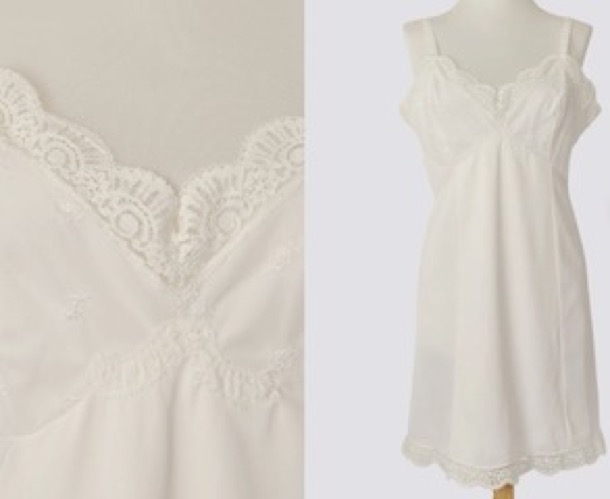
I must have made several mistakes and had to unpick the french seams around the bust several times and my work became very grubby and worn. I looked with envy at the neat and pristine garments of some of my classmates. Starting again was not an option so I decided to smuggle it out and fix it at home. This was strictly forbidden! In the general busyness in the storeroom as the girls put their sewing boxes on the shelves, I hid the offending item under my blazer. Even at home it was very difficult to resew neatly, because of all the needle holes and general grubbiness. At least I could move on with the easier straight seams and the hem. Thank goodness I was not caught smuggling the sewing back into my sewing box. I finished the garment but never wore it. I am sure I would only have received a D, which I would not have liked.
My next foray into sewing was in the first year of my Art and Craft course. The first year was “dressmaking”. I did not enjoy it much, but it was not horrific, as the petticoat had been. I certainly did not want to teach sewing, and I was never asked to, thank goodness.
Surprisingly, I have recently started sewing again. I, like many others, started sewing in lockdown during the Covid pandemic. I am part of a widespread sewing resurgence, facilitated by the technological advances that give me access to fabrics and patterns all over the world and in Melbourne too.
Choosing the fabric and pattern are the aspects of dressmaking that have changed the most. For instance, I recently bought a winter coat pattern and fabric. Once, I would have gone to a local shop and leafed through thick, well thumbed and worn.pattern books by Butterwick, McCalls and Vogue.
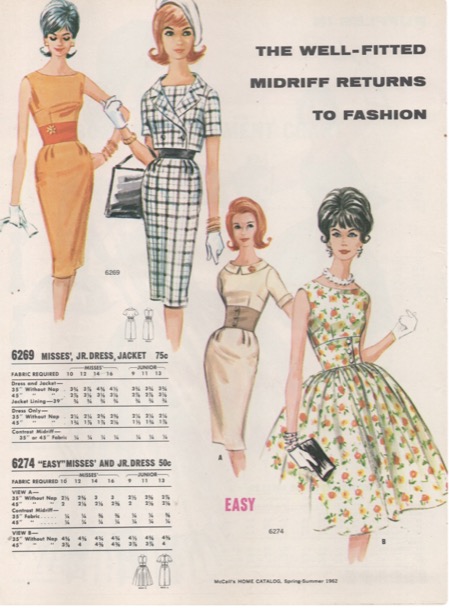
Instead, I chose my vintage coat pattern online, from a business in Germany. It was converted to a PDF format and delivery was almost instantaneous. Then the fun began as the pattern had to be printed. Two options were available for printing. The pattern could be printed on a home printer in A4, with the disadvantage of the pages needing to be joined with sticky tape. The alternative was to go to Officeworks and have the printing done for me, as one large sheet.
I have also discovered the joys of shopping worldwide for fabric. One of my favourites is a haberdasher in Hull in the UK, whose ethos is the creation of long lasting, wearable clothes from their patterns and their sustainably and ethically sourced fabrics. Merchant and Mills is part of a worldwide niche market, that is a reaction to the fast fashion industry, where very cheap, mass produced garments are expected to be thrown away after only a few wears.
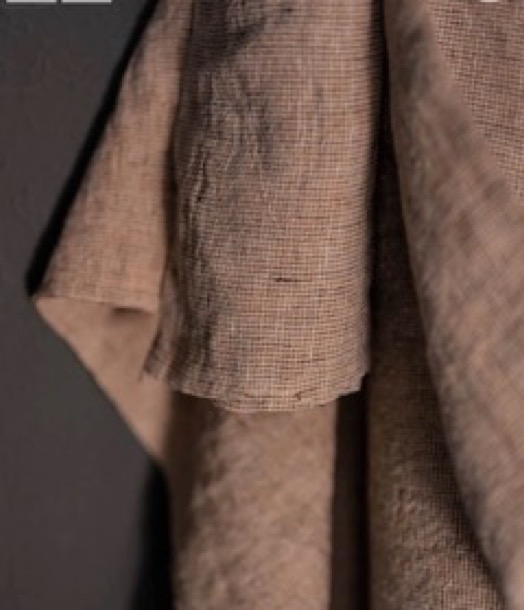
‘This European laundered linen, tumbled at the mill for softness, is a dusty peach and dark brown. It is produced in small batches in Eastern Europe where there is a strong heritage of spinning and weaving linen fabric’
MARGARET
One of the joys of retirement is having time for the little ones. For me, this included making special things for them, mostly sewing and knitting, and always geared to their particular interests and preferences.
Sometimes the occasion was birthdays and Christmases, but sometimes special requests came my way.
The first of these was a Christmas: matching pink fairy dresses for the three little girls. Here is Harper in hers:
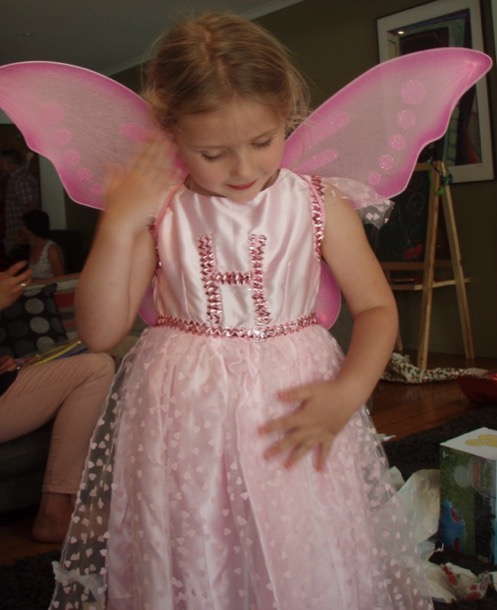
Later on, Harper’s colour preferences changed. For more than a year, she was all about cyan. You and I might have called this colour aqua or turquoise.
This was the colour specified for her special request for a jumper with a bunny on it for her, and one with a girl on it for her bunny.
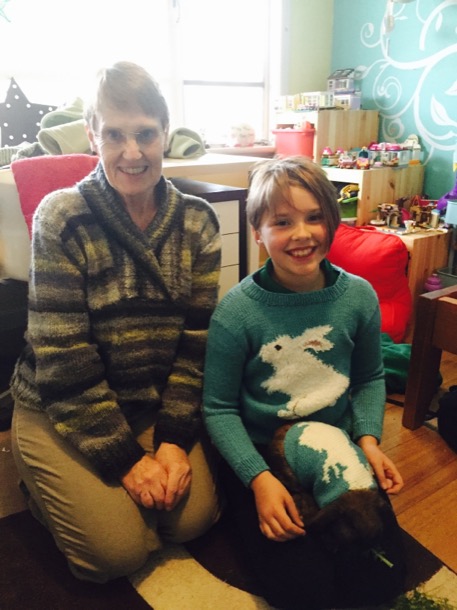
Aurelia was exactly the generation to be all about Disney’s Frozen. Her first frozen dress was a bought one, and she wore it out, before she tired of it. Thus it was, that my first Frozen job was to rehabilitate it:
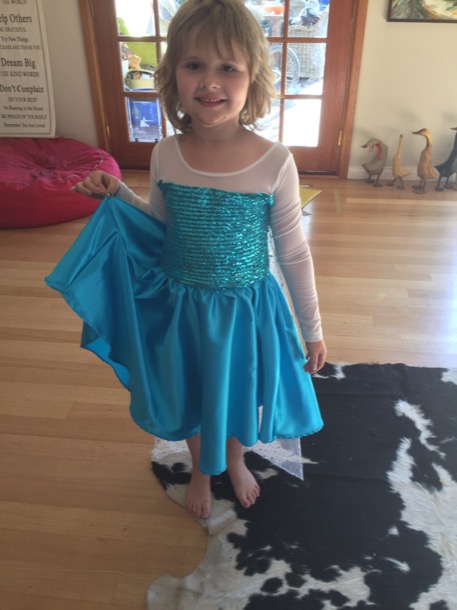
Then, when Frozen 2 came out, with that green dress, Aurelia and I trooped off to Spotlight to choose fabrics for her new one.
Here, she models the front and back of the final product:
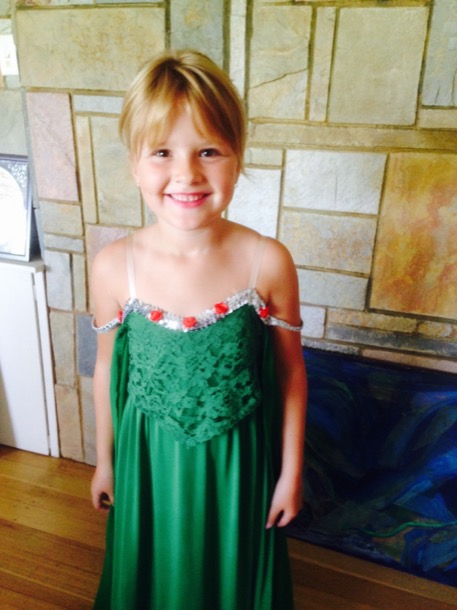
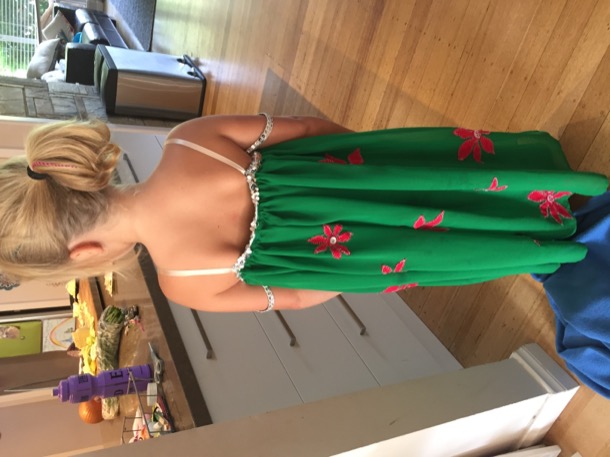
When my own grandchild came along, son of an artist, my initial contribution was a lacy baby blanket, not baby blue, but dark grey.
His first winter coat was also designed by Katherine, and made by me:
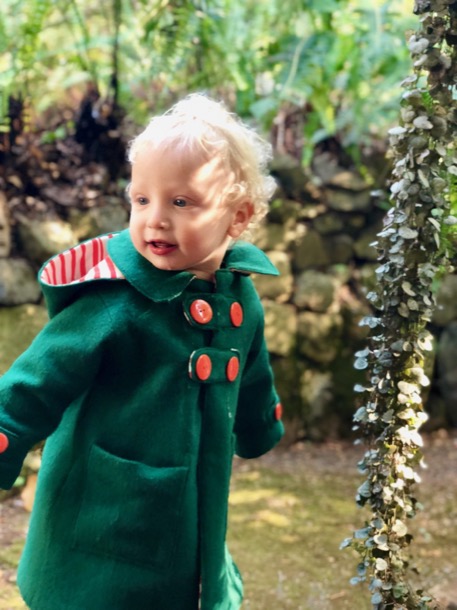
After a while I began knitting him jumpers to match his preferences.
The first one was Percy, his favourite Thomas the Tank Engine character:
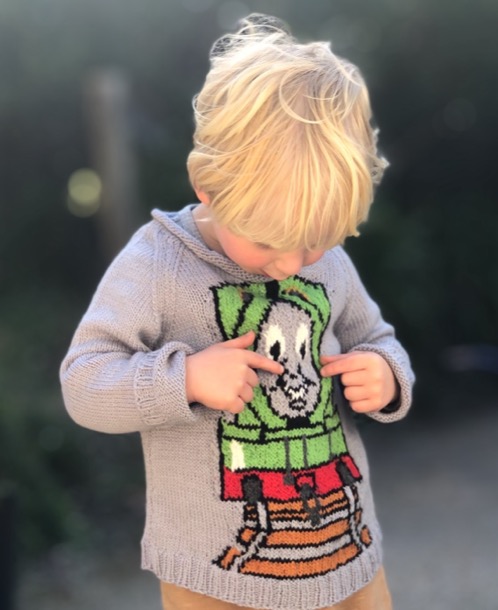
Then Bluey:
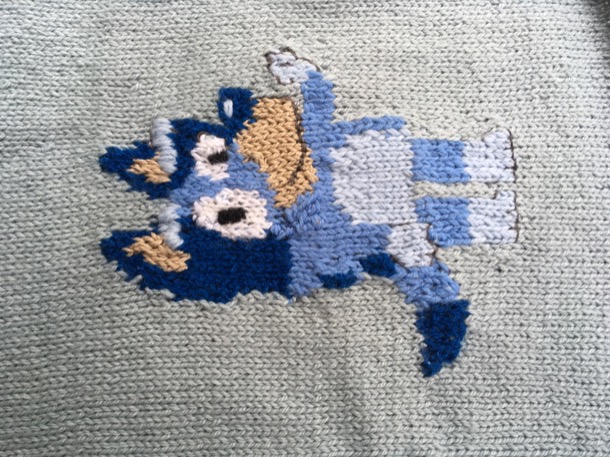
Optimus Prime:
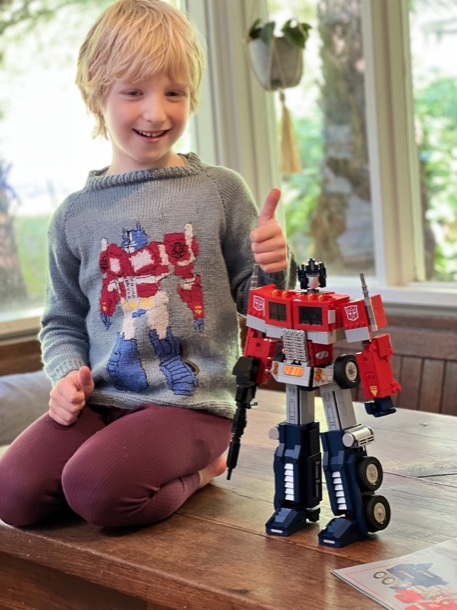
And, the most recent, a Minecraft T shirt, with, by request, a Sniffer:

THE ACCIDENTAL CRAFTIVIST.
In 2013, Chris and I became involved with the community protest against the building of a McDonald’s in Tecoma.
Over time, this evolved into groups of protestors spending many hours standing holding signs on the main road, and maintaining a vigil at the back of the building site.
My favoured place was sitting at the back gate, with a camp chair. Of course I took my knitting.
Here is a typical scene from “the site” at that time. The police were frequent visitors. For a long time, there was stalemate. We were backed by the union movement, and no building contractor could be found.
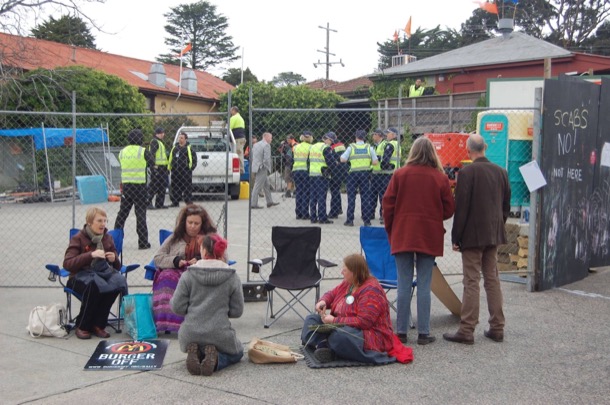
As the building progressed, we were no longer able to meet at the back gate. Every morning my friend Jan put up a little shelter we called “headquarters”. Every truck had to run the gauntlet of polite older women explaining why they should not enter the site.
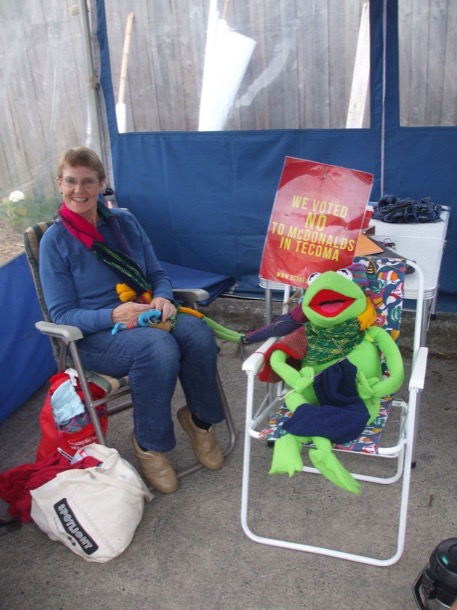
The Banner.
After a while, as we all finished off our various projects, we began knitting squares with all our scrap wool.
We became a group of close friends, and called ourselves The Picket Knitters.
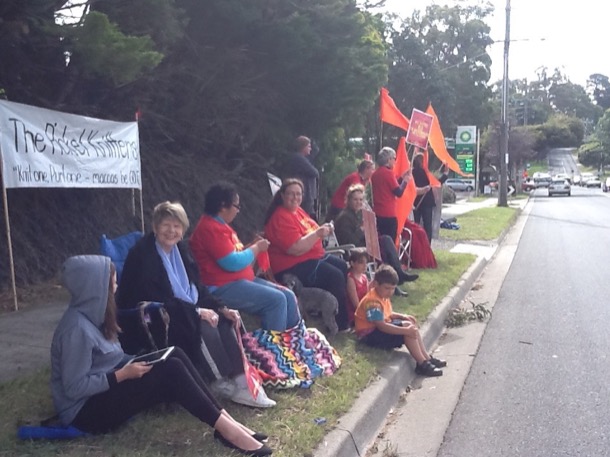
As our movement became more and more well known, we had people from all over the place sending squares. We embroidered the place of origin on some of them. This one came from Cairns.
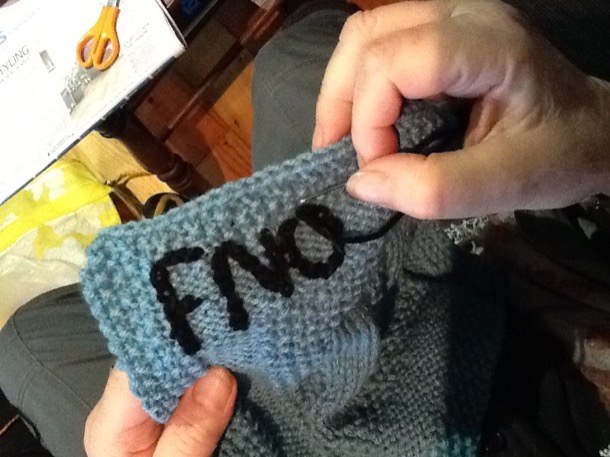
Eventually we put all the squares together, and made it into a banner.
By the time we had the official launch of the banner, the building was under way. Here, the knitters crouch behind the road barrier, with crossed needles. Sue and I are both there.
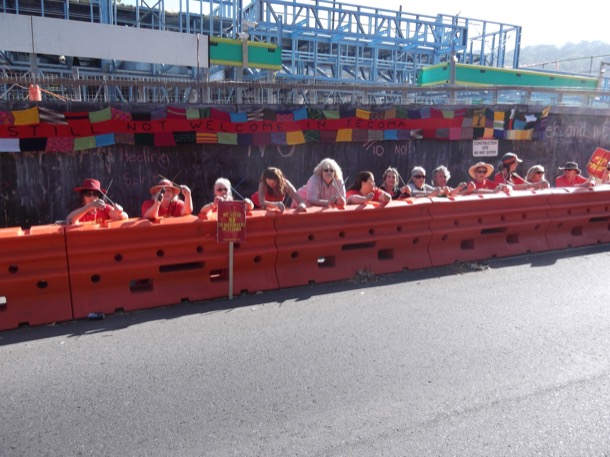
The local papers loved us.
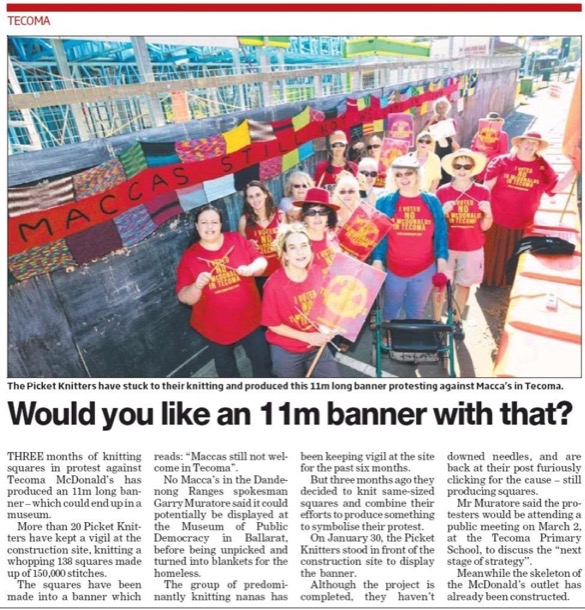
Eventually, we presented the banner to our fellow craftivists, the Knitting Nanas of Toolangi. We reconfigured the squares and it became part of their Great Tree Project.
Here it is decorating the base of one of the precious Mountain Ash trees.

Gnomageddon
“Gnome Maccas”, derived from our “No Maccas in Tecoma” slogan, spawned a range of Gnome related activities. The biggest of these was our Gnomageddon, where the community gathered to break the Guinness Book of Records record of the most people dressed as gnomes.
I made all our knitters a red gnome hat.
Here are a few Picket Knitters in their gnome outfits.
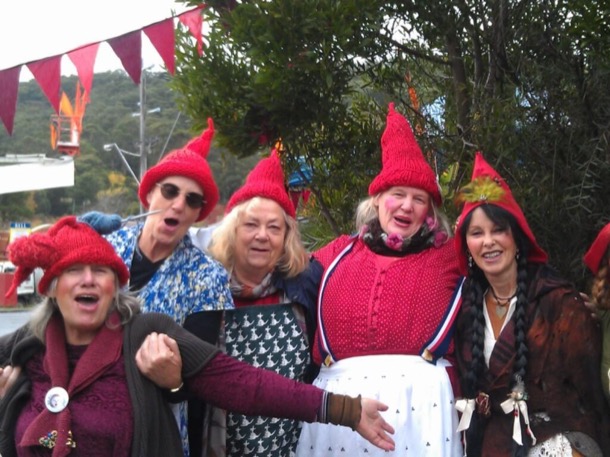
And even a gnome rat.
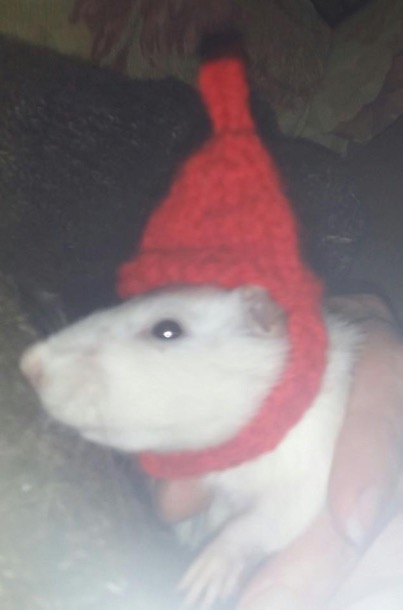
Once the McDonald’s in Tecoma opened, albeit usually deserted and initially the lowest grossing McDonald’s in the country, we continued to meet at each others houses.
In 2016, we all created tea cosies and entered them in the Fish Creek Tea Cosy Festival.
Here is my offering:
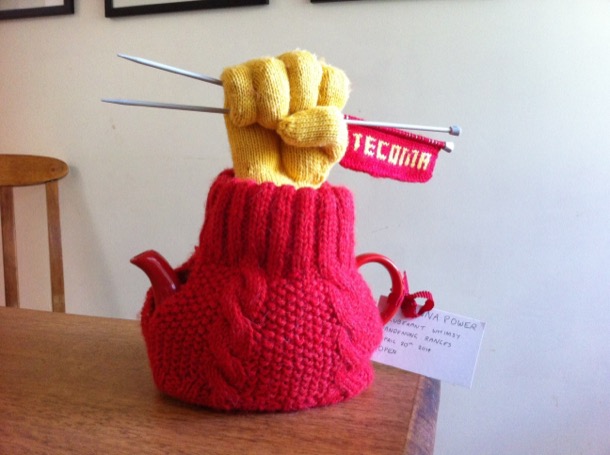
The local paper chased us up to find out what The Picket Knitters were doing now.
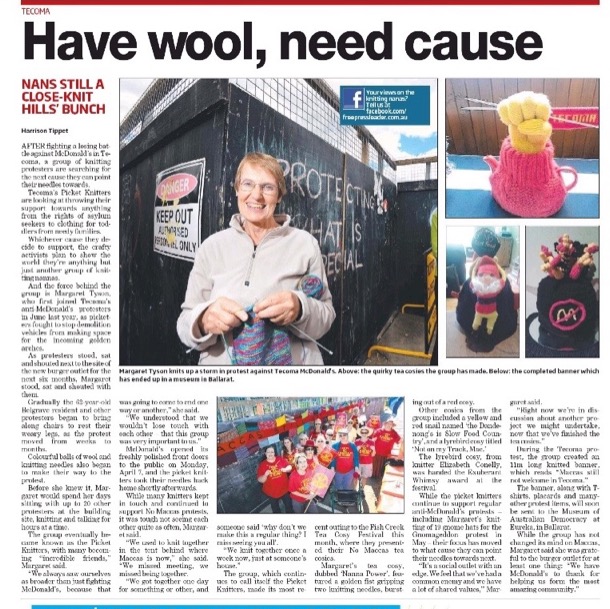
This article prompted a phone call from a Melbourne Radio Station shock jock. Based on the tone of the article, he was very excited by the idea he could paint us as serial protesters for hire. I very much enjoyed my live interview with him, where his aim was completely transparent. When he pressed me for possible “causes” we might move on to, clearly hoping for left wing politics he could ridicule, I listed a range of completely apolitical charities, and played my role of “just an ordinary person” who “of course didn’t want a McDonald’s so near the forest”.
We no longer knit together, but we do meet every fortnight for a lavish lunch and a long chat about how to put the world to rights.
ALICE
This is Sue and Margaret in about 1955.
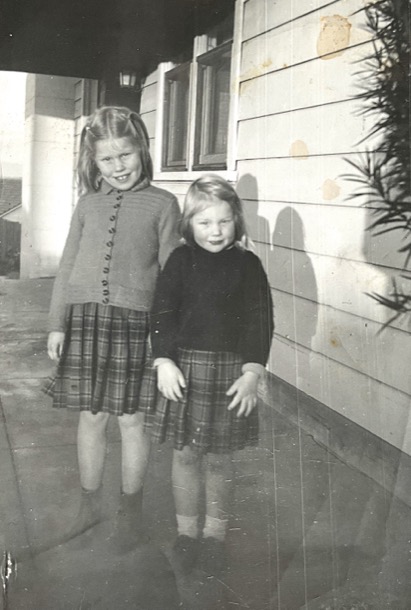
Two small girls, sisters, on a cold winter day in suburban Box Hill in the nineteen fifties.
What does it tell us of life then and the different world we lived in?
From the bottom up, starting with our shoes: We both are wearing lace up shoes, Margaret’s may have been hand me downs. She had a lot of these, as clothes were an expensive item to buy. Mine were my school shoes and these shoes were our one pair: worn to school or kinder, to play, to visit and to church on Sunday. On wet days we wore galoshes over them. These were rubberised over shoes, that fitted over the shoes, saving both feet and shoes from a soaking.
The life of our expensive shoes were prolonged by being reheeled by our father using his shoe last.
He also put little u shaped metal clips on the outer edge of the heel and toes to prevent wear on those vulnerable areas. Amazingly, looking for photos of ‘vintage ‘heel and toe clips I came across a host of You Tube videos of how to fix them to your shoes It is still a thing on leather soled shoes. The two worlds meet.
Our cotton socks were much the same as today. We only had a few pairs. Above these ankle socks were bare legs, in the depth of winter. We both remember cold legs on winter mornings: little girl plump legs with that blueish pink tinge.
At least we had woollen skirts that kept us warm. Once again only one, and home made by our mother. They were always tartan, pleated and then sewn to a cotton calico bodice.
The cotton bodice was at times a little grubby, but was usually hidden under our hand knitted woollen jumper or cardigan. Under this was a singlet possibly woollen. Margaret remembers shocking our mother. School Open Day was quite a big deal with many, mainly mothers in attendance. Mum walked into class confronted by an oblivious Margaret without her jumper on, as it was hot. She was sporting her tartan skirt, complete with a grubby bodice held up at the shoulder with a large safety pin. What a sight!
We think we wore these garments for almost everything we did during winter, from roller skating to going to school. We vaguely remember having twin sets to wear for best with the pleated skirt and a winter coat and raincoat, all worn with.our school, lace up shoes.
And then there was summer sewing.
It’s the week before Christmas. School has broken up, and four children, a dog and a cat clutter up the house. It’s hot, and there is no air conditioning. Not even a fan.
Christmas presents are partly organised but still require a few trips to Chadstone Shopping Centre.
In the garage, Dad is tuning the car, ready for its two hour trip to Shoreham camp. The tent and most of the camp furniture has already been set up, but a trailer full of odds and ends is still to be packed.
The plan is to leave early on Boxing Day.
In the centre of the house, between the kitchen and dining room, is a scene of colourful mayhem.
The sewing machine runs all day and into the night.
Cotton fabrics have been bought, perhaps at a discount fabric shop. They are spread out across the floor, with well used pattern pieces pinned to them. Mum crawls across the fabric cutting out multiple pieces. She makes enough shorts and tops for us each to have a set to wear and a set in the wash. There are hand-me-downs involved for me, the second child.
We find it hard to remember the details of her sewing. How were the seams finished? Were the necklines bound or faced? The hems were all hand sewn: we can both remember hems coming undone.
She didn’t cut the thread ends as she went, there were always multiple loose threads to trim off at the end.
In this photo, taken about 1958, little Sue and Margaret stand in the centre, in that year’s shorts and striped tops.
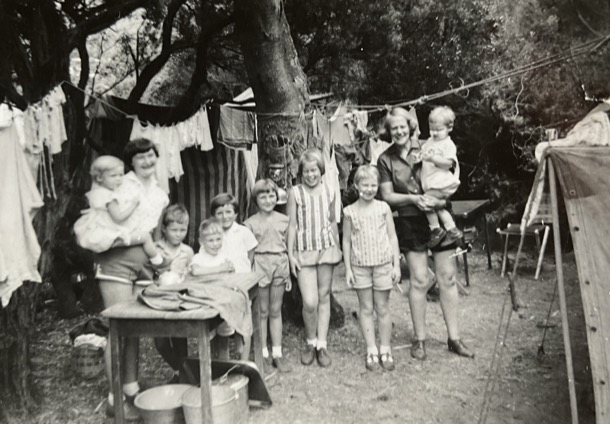
AUNTIE BERT
Our Great Auntie Bert was an important person in our lives and those of our extended family. We have fond memories of her kindness, but it was only as we researched the position of sewing in our family history, that we fully appreciated her dressmaking legacy. We knew that she had had a career as a dressmaker, and had run her own business. She passed on her dressmaking and fitting skills to Margaret and me, and to our mother and Auntie Marge, but we had not appreciated the thoughtfulness and kindness that was an intrinsic part of each garment.
My crushed strawberry viyella dress and Margaret’s mustard yellow check one epitomise this:
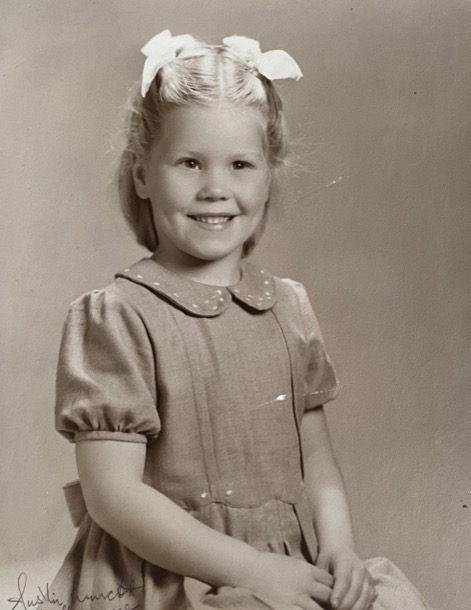
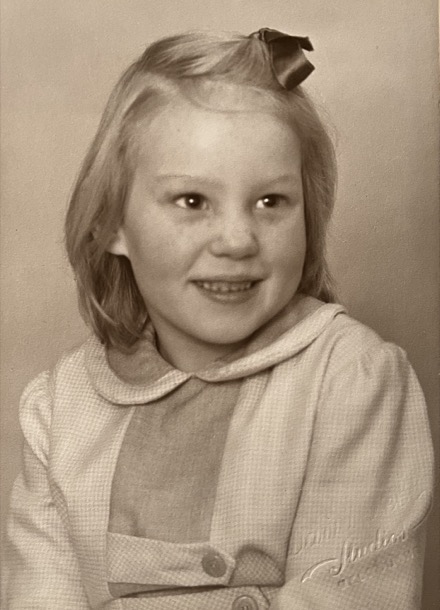
Now that I am sewing more, I can begin to appreciate the level of skill and detailing involved in the creation of these winter dresses. Margaret’s dress is made in a mustard check with a plain contrast panel and collar insert, all beautifully sewn and constructed. My dress, in one colour has detailed pleating on the bodice and skirt and a scalloped edge stitched waist that would have been fiendishly difficult to sew. Hopefully Auntie Bert would have enjoyed creating these “best” dresses, in which her love and care for her family are so evident.
Auntie Bert was also called upon to make many “best” dresses for the adult women of the family, some of them wedding outfits.
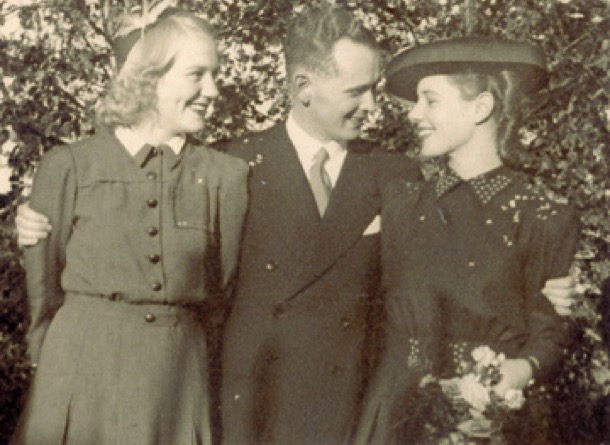
In my late teens when Auntie Bert was living in the flat behind our house, she made me a beautiful tweed winter overcoat , fully lined. I wish I still had it. During the process she taught me some of her tailoring techniques, for instance how to attach hair canvas to the collar , stitching it to ensure an even roll over.
During the last years of her life Auntie Bert lived with her sister’s family at the Cockatoo farm, as we explained in our post ‘Auntie Bert: A Sterling Character.’. During this time she was mostly clad in clothes she had made. In winter, she wore straight woollen skirts and layers of woollen jumpers and cardigans. In summer she wore a dress and cardigan, more often than not, covered by an apron. We never saw her in a beanie, which her sister wore constantly, even inside.
Sewing in many guises has been a feature of the lives of women in our family for generations. Probably there are more stories even further back that we are unaware of. In this short story we have gone from treadle machines, paper patterns and sewing for necessity, to sewing for pleasure and sewing as a form of protest.
Comments

